Fougasse d'Aigues-Mortes: Easy Recipe of the Brioche Dessert

Share
Ingredients
🍞 500 g of strong flour
🥚 3 medium eggs
🧴 125 ml of whipping cream, crème fraîche or milk if necessary
🍞 18g of fresh baker’s yeast or 6 g. of the dry
🍬 120 g. of sugar (80 for the dough and 40 for the topping)
🧂 8 g. of salt
🧈 150 g. butter (90 g. for the dough and 60 g. for the topping)
🍊 100 ml. orange blossom water (30 ml. for the dough and 70 ml. for the topping)
Fougasse is a type of bread typical of the south of France. It can be found in both its savoury and sweet versions . We are not going to talk about the savoury version, which is often enriched with cracklings, herbs or other ingredients , today , because when we mention fougasse d’Aigues-Mortes we are referring to a sweet version that is quite famous in the neighbouring country, French bread .
Specifically, the specialty we are referring to is a sweet , flat brioche-type bread that is a real delight. Light and moist, generously scented with orange blossom and with a generous topping of butter . You can find other traditional sweets on the blog such as Calisson d’ Aix, Normandy apple pie or the typical crepes .
This sweet is part of the “thirteen desserts”, a deep-rooted custom of the Provencal end-of-year festivities where on Christmas Day thirteen different sweets are placed on the table, representing Jesus and his twelve apostles.
es.
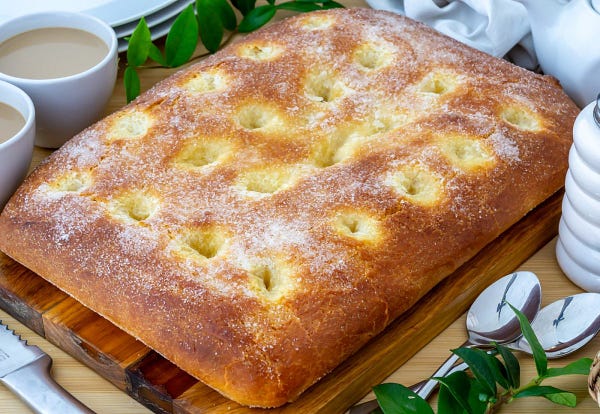
History and origin of the Fougasse d’Aigues-Mortes
Aigues-Mortes, from which today’s recipe is named, is a small French town located in the south of the country, in the Camargue , one of the busiest maritime areas of Provence. Also known as the little Carcassonne for its walled historic center, it is an essential tourist destination for those visiting the region.
Fougasse used to be reserved for those dates and it was customary for bakeries to offer to make it for free for anyone who brought them the ingredients. However, the devotion to this sweet was such that little by little the bakeries of the city extended the season until, today, we can find it all year round. It must be said that we can find as many recipes as there are bakeries that make it and that each one is kept under lock and key. The version that we bring you today could be said to have the common points of all of them and is the one that is taught in baking schools.
As we have said, the city is a tourist destination, so it is a must to visit one of its bakeries that have been making this specialty since 1912 (the oldest ones). In addition, taking advantage of the situation, it began to be used as one of the most representative souvenir gifts of the place. Something like what happens with the ensaimadas of Mallorca, so you can already imagine why the fougasse d’Aigues-Mortes became so famous , right?
Fougasse d’Aigues-Mortes: Step-by-step Recipe
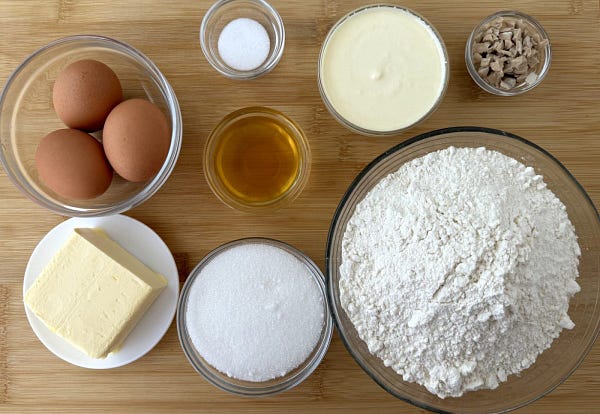
Pre-preparation of the dough
- In a large bowl or in the bowl of a food processor, add the flour, salt, yeast, 30 ml of orange blossom water, 80 grams of sugar, cream and beaten eggs. It is not necessary to follow the same order. We will leave the butter for later.
- We mix the ingredients of the dough until they are integrated and let it rest for 10 minutes so that the flour hydrates and makes it easier to knead later.
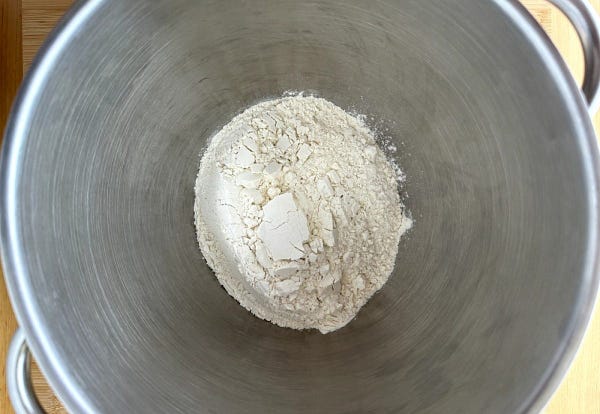

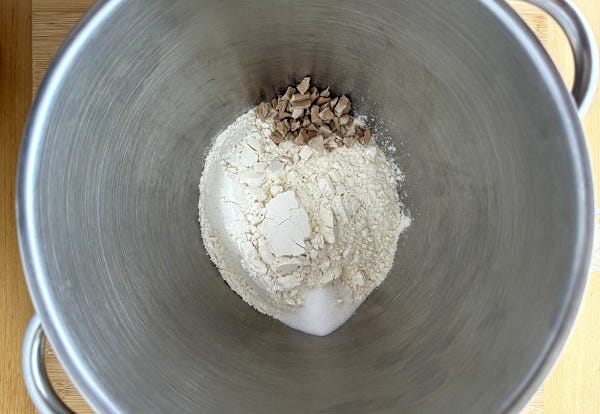
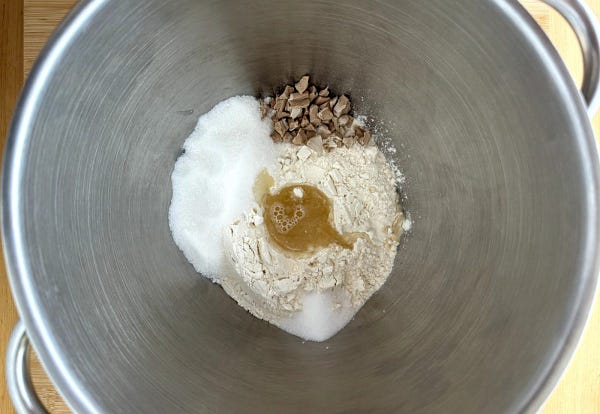
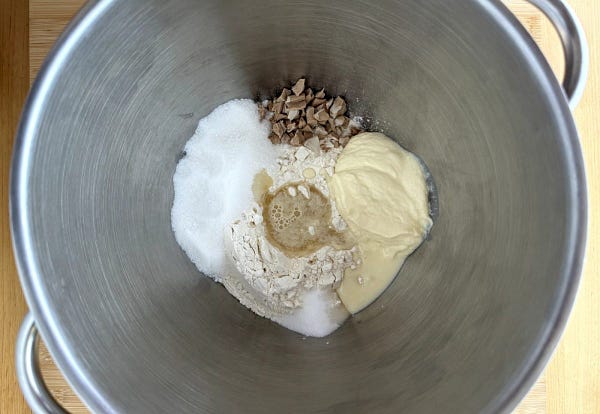
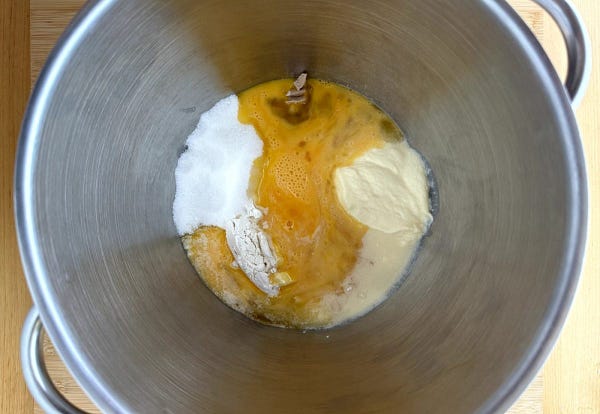
Kneading and adding the butter
- After the first resting time, we begin to knead for about 5 minutes and let it rest for another 5, since the resting time also contributes to kneading.
- We repeat the kneading and resting process two or three more times until the dough becomes very soft and comes away from the sides of the bowl.
- Once it is ready, we take the butter out of the fridge, cut it into cubes of about 90 g and add it to the dough in several batches, making sure to knead until the added butter is well integrated before adding more.
- Now comes the trickiest part, as we have to repeat the kneading and resting cycles until we manage to develop the dough membrane.
- To perform the membrane test and check if the dough is ready, take a bit of dough and gently stretch it with your fingers. If you can stretch it without it breaking until it is very thin and translucent, the dough is ready.
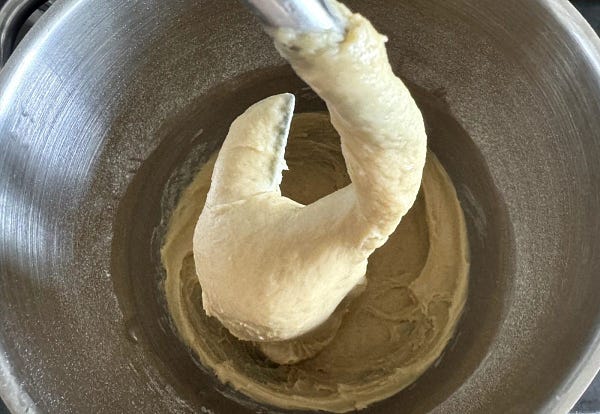
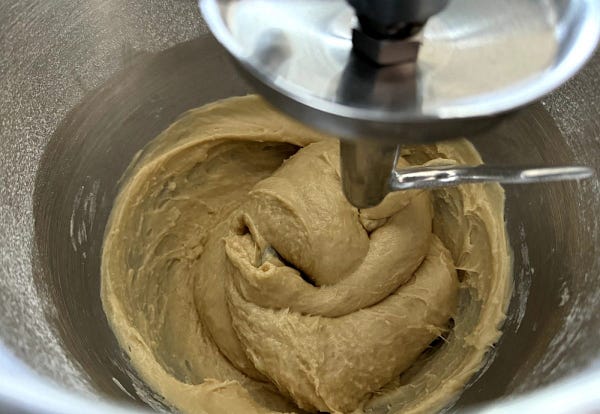
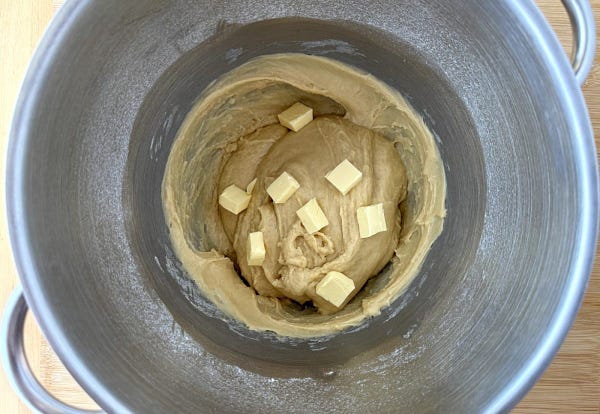

More Christmas Dessert Recipes 🍰
Chestnut almond cake chocolate glaze recipe | Crepes suzette sauce recipe | Italian style cheese panna cotta recipe | Homemade fried milk recipe | Andalusian sweet porridge cinnamon recipe | Fluffy chocolate cake recipe | Profiteroles with fillings recipe | Creamy santiago cake coulant recipe | Intxaursaltsa walnuts recipe
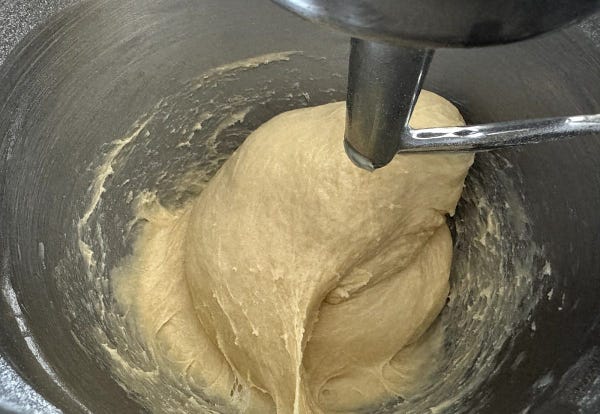
Cooling of the dough and first fermentation
- Once the butter is fully incorporated and the membrane is developed, we will proceed to form the dough into balls. To do this, we turn the dough with both hands, applying slight pressure downwards and towards the centre to create tension on the surface of the dough.
- Now take a large container, which can be sealed tightly if possible, and grease it lightly with butter. A very thin layer will be enough.
- We place the dough inside the container and let it rest covered in the refrigerator for 24 hours so that a slow fermentation takes place and the brioche’s own flavors develop.

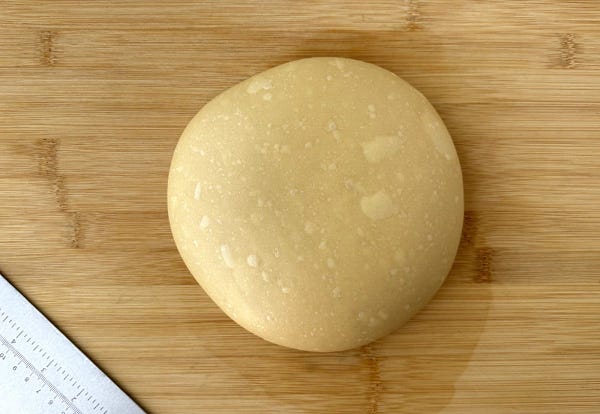

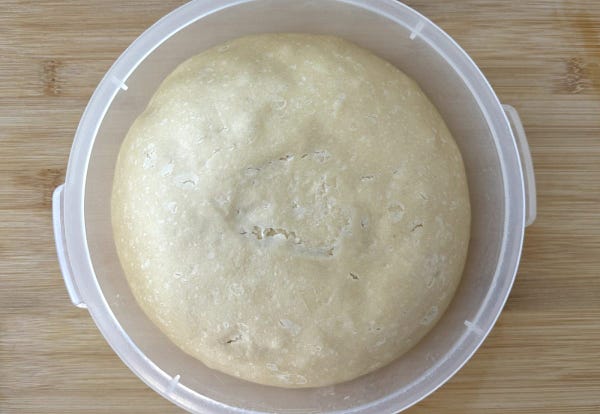

Brioche shaping and second fermentation
- After the rising time, we take the dough out of the refrigerator half an hour before continuing with the recipe so that it loses the cold and makes it easier to shape the brioche.
- Once tempered, we stretch the dough with the help of a rolling pin until we have a rectangle half a centimetre thick. It is not necessary to flour the work surface since the brioche dough, having a good amount of butter, does not stick very well.
- Once we have the desired shape, we place the dough on the baking tray previously lined with a sheet of baking paper or greased with butter and lightly floured.
- We cover the dough with a clean, slightly damp kitchen cloth and let it rest for an hour at room temperature for a second rise.


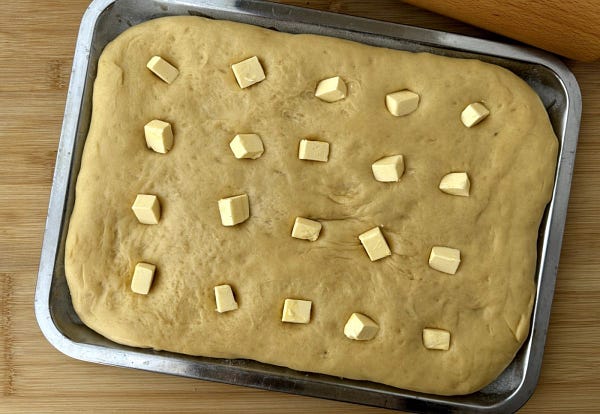
Baking and final presentation
- Once the second rising is complete, the brioche will be ready to bake, although we will first give it the characteristic touch of the fougasse. First, before we forget, we preheat the oven to 200 ºC, heat from above and below.
- To begin to give it the final shape, optionally, we can make small indentations in the dough with our finger, as is also done with focaccia, trying to make it more or less have a regular shape.
- We count the number of indentations that we have and cut the other 60 g of butter into as many squares as there are indentations and put them in them. If we haven’t made any, we will simply spread the softened butter on top.
- The last step of the assembly is to sprinkle the remaining 40 grams of sugar over the fougasse. It should be a generous layer.
- Next, place the fougasse in the oven, close the door and lower the temperature to 180º. Bake for 18 to 20 minutes or until golden brown to taste.
- Fresh from the oven, we moisten the brioche with the rest of the orange blossom water. We can use a spray bottle, a bottle or simply paint it over with a brush.
- To finish, place the fougasse on a rack to cool. It can be enjoyed either warm or cold.
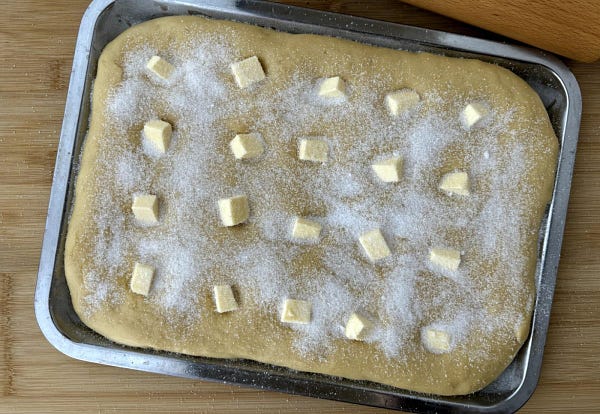

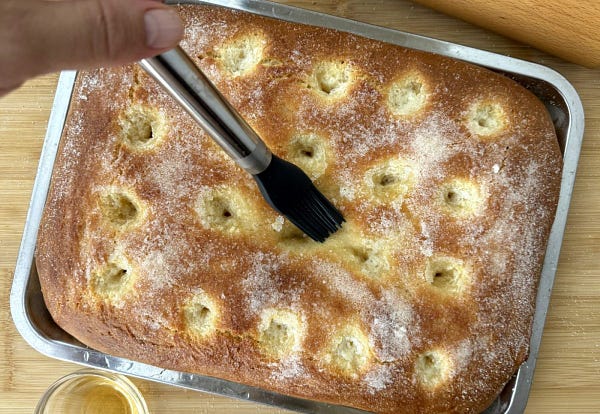
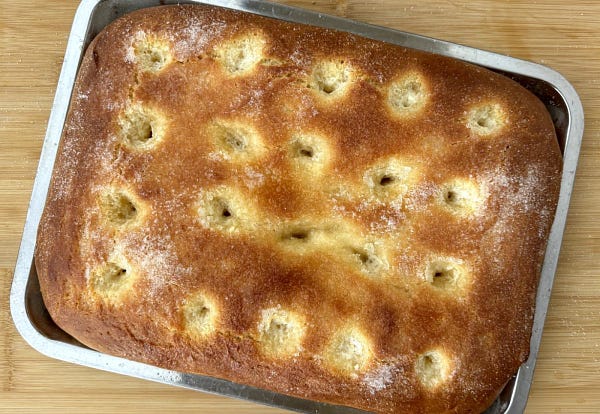


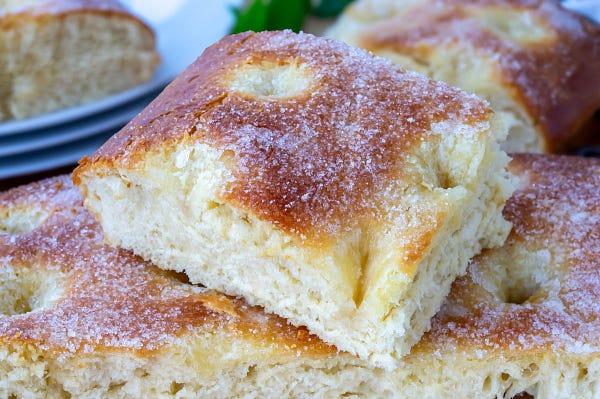
Tips for a perfect Fougasse d’Aigues-Mortes
- The type of flour is one of the key points to obtain a perfect brioche. For this type of sweet bread, you need a strong flour or baker’s flour with a high protein content, generally between 11% and 13%, which can withstand the large amount of butter and sugar that characterizes brioche and allow the dough to ferment properly.
- If we have a yeast that needs activation, we heat the cream a little, not more than 30 ºC, add the yeast and let it act for about 5 minutes or the time indicated by the manufacturer. After that time, we add it as another ingredient. It is important not to exceed the temperature, it has to be lukewarm, because if not we run the risk of killing the yeast and it will lose its action.
- The first resting time of the dough before kneading it is called autolysis and allows the flour to fully hydrate and the gluten to begin to develop. This makes subsequent kneading easier and improves the final texture of the dough. Don’t forget this step as it is quite noticeable.
- The kneading process can be done by hand, first in the bowl and then on the kitchen counter, or directly in the food processor with the hook-shaped kneading accessory.
- If during the kneading process we notice that the dough is a little dry, we can correct it with a little water or milk. To avoid overdoing it, we will add liquid spoon by spoon.
- It is important to add the butter to the dough little by little so that it is incorporated. If we add it all at once, we will end up with a greasy dough that is difficult to work with and will take much more work to integrate.
- Take the time you need to create the membrane of the dough, as this is what ensures that the gluten is well developed and will give the right consistency and texture to the brioche. Don’t skip this step! It may not seem like it, but in the end you get it.
- Ideally, the fougasse should be rectangular, but if it is a little oval around the edges, that is also fine.
- If you wish, you can also add the zest of 1 lemon and 1 orange to give it that touch that was given in the past.
- To preserve fougasse d’Aigues-Mortes, store it in a tightly sealed plastic bag or airtight container at room temperature, where it will keep for 2 to 3 days. If you want to keep it for longer, the ideal is to freeze it. Then, to enjoy it in optimal conditions, simply let it defrost at room temperature or warm it slightly in the oven to restore its fluffy texture and freshly made flavour.
Fougasse d’Aigues-Mortes: Easy Recipe of the Brioche Dessert















